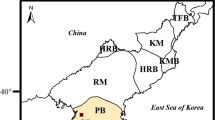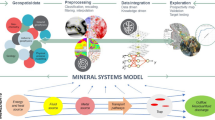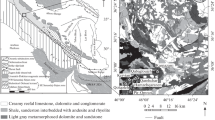Abstract
Three-dimensional (3D) prospectivity modeling based on the weights of evidence and fuzzy logic methods was carried out for the Honghai volcanogenic massive sulfide Cu–Zn deposit in eastern Tianshan, northwestern China. A 3D geological model was constructed using geological maps, geological plans, cross sections, and boreholes. The geological model and metallogenic model of the Honghai deposit were used to generate 3D predictor maps. The weights of evidence method and fuzzy logic were then used to integrate the various predictor maps to create prospectivity maps. Capture efficiency curves were subsequently used to delineate high-prospectivity areas in the prospectivity maps. The weights of evidence method and fuzzy logic delineated 96.13% and 90.60%, respectively, of the known mineralization in the high-prospectivity areas, which occupied about 5.89% and 6.33% of the study area. Receiver operating characteristic (ROC) curves were used to evaluate the performance of the two methods, with both showing area under the curve values > 0.5, which indicates the effectiveness of both methods for 3D prospectivity modeling of the Honghai deposit. However, the weights of evidence method generally performed better than fuzzy logic for identification of the concealed and deep-seated Honghai deposit. Conversely, fuzzy logic exhibited better generalization capability. Based on the findings of this study, the high-prospectivity areas located in the south of the known orebody of the Honghai deposit should be considered as high-priority targets for future mineral exploration. This study aims to enable more effective delineation of concealed and deep-seated exploration targets in the Honghai deposit.












Similar content being viewed by others
References
Abedi M, Norouzi GH, Bahroudi A (2012) Support vector machine for multi-classification of mineral prospectivity areas. Comput Geosci 46:272–283
Agterberg FP (1992) Combining indicator patterns in weights of evidence modeling for resource evaluation. Nat Resour Res 1(1):39–50
Agterberg FP (2011) A modified weights-of-evidence method for regional mineral resource estimation. Nat Resour Res 20(2):95–101
Agterberg FP, Bonham-Carter GF, Wright DF (1990) Statistical pattern integration for mineral exploration. In: GaÁL G, Merriam DF (eds) Computer applications in resource estimation. Pergamon, Amsterdam, pp 1–21
Apel M (2006) From 3d geomodelling systems towards 3d geoscience information systems: data model, query functionality, and data management. Comput Geosci 32(2):222–229
Bergmann R, Ludbrook J, Spooren WPJM (2000) Different outcomes of the Wilcoxon–Mann–Whitney test from different statistics packages. Am Stat 54(1):72–77
Bonham-Carter GF (1994) Geographic information systems for geoscientists, modelling with GIS. Pergamon, New York, p 398
Bonham-Carter GF, Agterberg FP, Wright DF (1988) Integration of geological datasets for gold exploration in Nova Scotia. Photogramm Eng Remote Sens 54:1585–1592
Brown WM, Gedeon TD, Groves DI, Barnes RG (2000) Artificial neural networks: a new method for mineral prospectivity mapping. Aust J Earth Sci 47(4):757–770
Carranza EJM (2004) Weights of evidence modeling of mineral potential: a case study using small number of prospects, Abra, Philippines. Nat Resour Res 13(3):173–187
Carranza EJM (2009) Chapter 7: Knowledge-driven modeling of mineral prospectivity. Handb Explor Environ Geochem 11:189–247
Carranza EJM, Laborte AG (2015a) Data-driven predictive mapping of gold prospectivity, Baguio district, Philippines: application of random forests algorithm. Ore Geol Rev 71:777–787
Carranza EJM, Laborte AG (2015b) Data-driven predictive modeling of mineral prospectivity using random forests: a case study in Catanduanes Island (Philippines). Nat Resour Res 25(1):35–50
Carranza EJM, Laborte AG (2015c) Random forest predictive modeling of mineral prospectivity with small number of prospects and data with missing values in Abra (Philippines). Comput Geosci 74:60–70
Carranza EJM, Sadeghi M (2010) Predictive mapping of prospectivity and quantitative estimation of undiscovered VMS deposits in Skellefte district (Sweden). Ore Geol Rev 38(3):219–241
Carranza EJM, Mangaoang JC, Hale M (1999) Application of mineral exploration models and GIS to generate mineral potential maps as input for optimum land-use planning in the Philippines. Nat Resour Res 8(2):165–173
Chen YJ (2000) Progress in the study of Central Asia-type orogenesis-metallogenesis in Northwest China. Geol J Chin Univ 6:17–22 (in Chinese with English abstract)
Chen Y (2015) Mineral potential mapping with a restricted Boltzmann machine. Ore Geol Rev 71:749–760
Chen Y, Wu W (2016) A prospecting cost-benefit strategy for mineral potential mapping based on ROC curve analysis. Ore Geol Rev 74:26–38
Chen Y, Wu W (2017) Mapping mineral prospectivity using an extreme learning machine regression. Ore Geol Rev 80:200–213
Chen Y, Wu W (2019) Isolation forest as an alternative data-driven mineral prospectivity mapping method with a higher data-processing efficiency. Nat Resour Res 28(1):31–46
Chen YJ, Pirajno F, Wu G, Qi JP, Xiong XL (2012) Epithermal deposits in North Xinjiang, NW China. Int J Earth Sci 101(4):889–917
Deng XH, Wang JB, Pirajno F, Wang YW, Li YC, Li C, Zhou LM, Chen YJ (2016) Re–Os dating of chalcopyrite from selected mineral deposits in the Kalatag district in the eastern Tianshan Orogen, China. Ore Geol Rev 77:72–81
Deng XH, Wang JB, Santosh M, Li YC, Wang YW, Mao QG, Long LL, Chen X (2018a) New 40Ar/39Ar ages from the Kalatag district in the Eastern Tianshan, NW China: constraints on the timing of Cu mineralization and stratigraphy. Ore Geol Rev 100:250–262
Deng XH, Wang JB, Santosh M, Wang YW, Long LL, Zhang HQ, Yang LY, Xu J, Chen X, Chen L, Somerville ID (2018b) Early Paleozoic volcanic rocks with VMS mineralization from eastern Tianshan Orogen: implication for tectonic evolution. Geol J 53(5):2178–2192
Deng XH, Mathur R, Li Y, Mao QG, Wu YS, Yang LY, Chen X, Xu J (2019) Copper and zinc isotope variation of the VMS mineralization in the Kalatag district, eastern Tianshan, NW China. J Geochem Explor 196:8–19
D’Ercole C, Groves DI, Knox-Robinson CM (2000) Using fuzzy logic in a Geographic Information System environment to enhance conceptually based prospectivity analysis of Mississippi Valley-type mineralisation. Aust J Earth Sci 47(5):913–927
Fabbri AG, Chung CJ (2008) On blind tests and spatial prediction models. Nat Resour Res 17(2):107–118
Fawcett T (2006) An introduction to ROC analysis. Pattern Recogn Lett 27(8):861–874
Ford A, Miller JM, Mol AG (2015) A comparative analysis of weights of evidence, evidential belief functions, and fuzzy logic for mineral potential mapping using incomplete data at the scale of investigation. Nat Resour Res 25(1):19–33
Gao Y, Zhang Z, Xiong Y, Zuo R (2016) Mapping mineral prospectivity for Cu polymetallic mineralization in southwest Fujian Province, China. Ore Geol Rev 75:16–28
Harris D, Pan G (1999) Mineral favorability mapping: a comparison of artificial neural networks, logistic regression, and discriminant analysis. Nat Resour Res 8(2):93–109
Hu X, Yuan F, Li X, Jowitt SM, Jia C, Zhang M, Zhou T (2018) 3D characteristic analysis-based targeting of concealed Kiruna-type Fe oxide-apatite mineralization within the Yangzhuang deposit of the Zhonggu orefield, southern Ningwu volcanic basin, middle-lower Yangtze River metallogenic Belt, China. Ore Geol Rev 92:240–256
Huang J, Chen H, Han J, Deng X, Lu W, Zhu R (2018) Alteration zonation and short wavelength infrared (SWIR) characteristics of the Honghai VMS Cu-Zn deposit, Eastern Tianshan, NW China. Ore Geol Rev 100:263–279
Joly A, Porwal A, Mccuaig C (2010) 3D geophysical and geological modeling for understanding the gold mineral systems in the Tanami Orogen, Western Australia. In: EGU general assembly conference, p 341
Joly A, Porwal A, McCuaig TC (2012) Exploration targeting for orogenic gold deposits in the Granites-Tanami Orogen: mineral system analysis, targeting model and prospectivity analysis. Ore Geol Rev 48:349–383
Kaufmann O, Martin T (2008) 3D geological modelling from boreholes, cross-sections and geological maps, application over former natural gas storages in coal mines. Comput Geosci-UK 34:278–290
Kim YH, Choe KU, Ri RK (2019) Application of fuzzy logic and geometric average: a Cu sulfide deposits potential mapping case study from Kapsan Basin, DPR Korea. Ore Geol Rev 107:239–247
Li WQ, Wang R, Wang H, Xia B (2006) Geochemistry and petrogenesis of the Kalatag intrusion in the “Tuha window”. Geol China 33:559–565 (in Chinese with English abstract)
Li X, Yuan F, Zhang M, Jia C, Jowitt SM, Ord A, Zheng T, Hu X, Li Y (2015) Three-dimensional mineral prospectivity modeling for targeting of concealed mineralization within the Zhonggu iron orefield, Ningwu Basin, China. Ore Geol Rev 71:633–654
Li X, Yuan F, Zhang M, Jowitt SM, Ord A, Zhou T, Dai W (2019) 3D computational simulation-based mineral prospectivity modeling for exploration for concealed Fe–Cu skarn-type mineralization within the Yueshan orefield, Anqing district, Anhui Province, China. Ore Geol Rev 105:1–17
Lisitsin VA, González-Álvarez I, Porwal A (2013) Regional prospectivity analysis for hydrothermal-remobilised nickel mineral systems in western Victoria, Australia. Ore Geol Rev 52:100–112
Lü Q, Qi G, Yan J (2013) 3D geologic model of Shizishan ore field constrained by gravity and magnetic interactive modeling: a case history. Geophysics 78(1):25–35
Malehmir A, Thunehed H, Tryggvason A (2007) The Paleoproterozoic Kristineberg mining area, northern Sweden: results from integrated 3D geophysical and geologic modeling, and implications for targeting ore deposits. Geophysics 74(1):9
Mao QG (2014) The geological, metallogenesis and metallogenic prognosis studies of the Kalatage copper polymetallic ore district in eastern Tianshan, NW China. Post-Doctoral Research Report 1–154 (in Chinese)
Mao QG, Fang TH, Wang JB, Wang SL, Wang N (2010) Geochronology studies of the Early Paleozoic Honghai massive sulfide deposits and its geological significance in Kalatage area, Eastern Tianshan Mountain. Acta Petrol Sin 26:3017–3026 (in Chinese with English abstract)
Mao QG, Wang JB, Fang TH, Zhu JJ, Fu WW, Yu MJ, Huang XK (2015) Lead and sulfur isotope studies of sulfides from Honghai VMS-type deposit in Kalatage ore belt of eastern Tianshan Mountains. Miner Depos 34:730–744 (in Chinese with English abstract)
Mao QG, Wang JB, Fang TH, Yu MJ, Zhu JJ, Zhang R, Fu WW, Gao WH (2016) Geological characteristics of Honghai VMS type deposit of Kalatage ore belt and discussion of genesis type in the eastern Tianshan. Geotech Eng World 7:17–30 (in Chinese with English abstract)
McKay G, Harris JR (2015) Comparison of the data-driven random forests model and a knowledge-driven method for mineral prospectivity mapping: a case study for gold deposits around the Huritz Group and Nueltin Suite, Nunavut, Canada. Nat Resour Res 25(2):125–143
Moradi M, Basiri S, Kananian A, Kabiri K (2014) Fuzzy logic modeling for hydrothermal gold mineralization mapping using geochemical, geological, ASTER imageries and other geo-data, a case study in Central Alborz, Iran. Earth Sci Inform 8(1):197–205
Mutele L, Billay A, Hunt JP (2017) Knowledge-driven prospectivity mapping for granite-related polymetallic Sn–F–(REE) mineralization, Bushveld Igneous Complex, South Africa. Nat Resour Res 26(4):535–552
Najafi A, Karimpour MH, Ghaderi M (2014) Application of fuzzy AHP method to IOCG prospectivity mapping: a case study in Taherabad prospecting area, eastern Iran. Int J Appl Earth Obs 33:142–154
Nielsen SHH, Cunningham F, Hay R, Partington G, Stokes M (2015) 3D prospectivity modelling of orogenic gold in the Marymia Inlier, Western Australia. Ore Geol Rev 71:578–591
Nykänen V, Lahti I, Niiranen T, Korhonen K (2015) Receiver Operating Characteristics (ROC) as validation tool for prospectivity models—a magmatic Ni–Cu case study from the Central Lapland greenstone belt, Northern Finland. Ore Geol Rev 71:853–860
Payne CE, Cunningham F, Peters KJ, Nielsen S, Puccioni E, Wildman C, Partington GA (2015) From 2D to 3D: prospectivity modelling in the Taupo Volcanic Zone, New Zealand. Ore Geol Rev 71:558–577
Porwal A, Carranza EJM (2001) Extended weights-of-evidence modelling for predictive mapping of base metal deposit potential in Aravalli province. Explor Min Geol 10(4):273–287
Porwal A, Carranza EJM, Hale M (2003) Knowledge-driven and data-driven fuzzy models for predictive mineral potential mapping. Nat Resour Res 12(1):1–25
Porwal A, Carranza EJM, Hale M (2006) Bayesian network classifiers for mineral potential mapping. Comput Geosci 32(1):1–16
Porwal A, González-Álvarez I, Markwitz V, McCuaig TC, Mamuse A (2010) Weights-of-evidence and logistic regression modeling of magmatic nickel sulfide prospectivity in the Yilgarn Craton, Western Australia. Ore Geol Rev 38(3):184–196
Porwal A, Das RD, Chaudhary B, Gonzalez-Alvarez I, Kreuzer O (2015) Fuzzy inference systems for prospectivity modeling of mineral systems and a case-study for prospectivity mapping of surficial Uranium in Yeelirrie Area, Western Australia. Ore Geol Rev 71:839–852
Qin KZ, Fang TH, Wang SL, Zhu BQ, Feng YM, Yu HF, Xiu QY (2002) Plate tectonics division, evolution and metallogenic settings in Eastern Tianshan Mountains, NW-China. Xinjiang Geol 20(4):302–308 (in Chinese with English abstract)
Qin KZ, Su BX, Sakyi PA, Tang DM, Li XH, Sun H, Xiao QH, Liu PP (2011) SIMS zircon U–Pb geochronology and Sr–Nd isotopes of Ni–Cu-bearing mafic-ultra-mafic intrusions in eastern Tianshan and Beishan in correlation with flood basalts in Tarim Basin (NW China): constraints on a ca. 280 Ma mantle plume. Am J Sci 311:237–260
Reddy RKT, Bonham-Carter GF (1991) A decision-tree approach to mineral potential mapping in Snow Lake Area, Manitoba. Can J Remote Sens 17(2):191–200
Rodriguez-Galiano V, Sanchez-Castillo M, Chica-Olmo M, Chica-Rivas M (2015) Machine learning predictive models for mineral prospectivity: an evaluation of neural networks, random forest, regression trees and support vector machines. Ore Geol Rev 71:804–818
Sandham W, Leggett M, Aminzadeh F (2003) Geophysical applications of artificial neural networks and fuzzy logic. Kluwer Academic, Norwell, p 348
Sengör AMC, Natal’In BA, Burtman VS (1993) Evolution of the Altaid tectonic collage and Palaeozoic crustal growth in Eurasia. Nature 364:299–307
Singer DA, Kouda R (1996) Application of a feedforward neural network in the search for Kuroko deposits in the Hokuroku district, Japan. Math Geol 28(4):1017–1023
Singer DA, Kouda R (1999) A comparison of the weights-of-evidence method and probabilistic neural networks. Nat Resour Res 8(4):287–298
Sprague K, de Kemp E, Wong W, McGaughey J, Perron G, Barrie T (2006) Spatial targeting using queries in a 3-D GIS environment with application to mineral exploration. Comput Geosci 32(3):396–418
Sun Y, Wang G, Fang T, Feng Y, Wang X (2013) Three-dimensional geological modeling of the Honghai massive sulfide deposit in Xinjiang and its exploration application. Geol Prospect 49:179–184 (in Chinese with English abstract)
Tessema A (2017) Mineral systems analysis and artificial neural network modeling of chromite prospectivity in the Western Limb of the Bushveld Complex, South Africa. Nat Resour Res 26(4):465–488
Wang JB, Wang YW, He ZH (2006) Ore deposits as a guide to the tectonic evolution in the east Tianshan mountains, NW China. Geol China 33:461–469 (in Chinese with English abstract)
Wang G, Zhang S, Yan C, Song Y, Sun Y, Li D, Xu F (2011) Mineral potential targeting and resource assessment based on 3D geological modeling in Luanchuan region, China. Comput Geosci 37(12):1976–1988
Wang G, Zhu Y, Zhang S, Yan C, Song Y, Ma Z, Hong D, Chen T (2012) 3D geological modeling based on gravitational and magnetic data inversion in the Luanchuan ore region, Henan Province, China. J Appl Geophys 80:1–11
Wang G, Li R, Carranza EJM, Zhang S, Yan C, Zhu Y, Qu J, Hong D, Song Y, Han J, Ma Z, Zhang H, Yang F (2015) 3D geological modeling for prediction of subsurface Mo targets in the Luanchuan district, China. Ore Geol Rev 71:592–610
Wang G, Du W, Carranza EJM (2017) Remote sensing and GIS prospectivity mapping for magmatic-hydrothermal base- and precious-metal deposits in the Honghai district, China. J Afr Earth Sci 128:97–115
Windley BF, Alexeiev D, Xiao WJ, Kroner A, Badarch G (2007) Tectonic models for accretion of the Central Asian Orogenic Belt. J Geol Soc Lond 164:31–47
Xiao W, Windley BF, Allen MB, Han C (2013) Paleozoic multiple accretionary and collisional tectonics of the Chinese Tianshan orogenic collage. Gondwana Res 23(4):1316–1341
Xiao K, Li N, Porwal A, Holden EJ, Bagas L, Lu Y (2015) GIS-based 3D prospectivity mapping: a case study of Jiama copper-polymetallic deposit in Tibet, China. Ore Geol Rev 71:611–632
Xu XY, He SP, Wang HL, Chen JL (2009) Geological background map of mineralization in eastern Tianshan–Beishan Area. Geological Publishing House, Beijing (in Chinese)
Yang F, Wang G, Santosh M, Li R, Tang L, Cao H, Guo N, Liu C (2017) Delineation of potential exploration targets based on 3D geological modeling: a case study from the Laoangou Pb–Zn–Ag polymetallic ore deposit, China. Ore Geol Rev 89:228–252
Yousefi M, Carranza EJM (2015) Fuzzification of continuous-value spatial evidence for mineral prospectivity mapping. Comput Geosci 74:97–109
Yousefi M, Carranza EJM (2017) Union score and fuzzy logic mineral prospectivity mapping using discretized and continuous spatial evidence values. J Afr Earth Sci 128:47–60
Yousefi M, Kamkar-Rouhani A, Carranza EJM (2014) Application of staged factor analysis and logistic function to create a fuzzy stream sediment geochemical evidence layer for mineral prospectivity mapping. Geochem: Explor Environ, Anal 14(1):45–58
Yuan F, Li X, Zhang M, Jowitt SM, Jia C, Zheng T, Zhou T (2014) Three-dimensional weights of evidence-based prospectivity modeling: a case study of the Baixiangshan mining area, Ningwu Basin, Middle and Lower Yangtze Metallogenic Belt, China. J Geochem Explor 145:82–97
Zadeh LA (1965) Fuzzy sets. Inf Control 8(3):338–353. https://doi.org/10.1016/S0019-9958(65)90241-X
Zhang N, Zhou K, Du X (2017) Application of fuzzy logic and fuzzy AHP to mineral prospectivity mapping of porphyry and hydrothermal vein copper deposits in the Dananhu-Tousuquan island arc, Xinjiang, NW China. J Afr Earth Sci 128:84–96
Zheng J, Mao J, Yang F, Liu F, Zhu Y (2015) The post-collisional Cihai iron skarn deposit, eastern Tianshan, Xinjiang, China. Ore Geol Rev 67:244–254
Acknowledgements
This work was supported by Opening Subject of Key Laboratories in the Xinjiang Uygur Autonomous Region (grant no. 2018D04025), National Key Research and Development Program of China (grant no. 2018YFC0604006-4), Strategic Priority Research Program of the Chinese Academy of Sciences (grant no. XDA19030204), and Light of West China program of the China Academy of Science.
Author information
Authors and Affiliations
Corresponding author
Rights and permissions
About this article
Cite this article
Tao, J., Yuan, F., Zhang, N. et al. Three-Dimensional Prospectivity Modeling of Honghai Volcanogenic Massive Sulfide Cu–Zn Deposit, Eastern Tianshan, Northwestern China Using Weights of Evidence and Fuzzy Logic. Math Geosci 53, 131–162 (2021). https://doi.org/10.1007/s11004-019-09844-2
Received:
Accepted:
Published:
Issue Date:
DOI: https://doi.org/10.1007/s11004-019-09844-2




